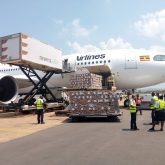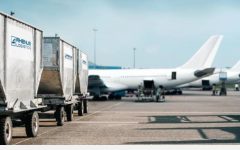 The Association of Asia Pacific Airlines (AAPA) reported positive early-year traffic figures for January 2024, indicating a promising start with substantial increases in international passenger and cargo traffic, spurred by strong demand preceding the Lunar New Year celebrations. In January, airlines in the region transported a total of 27.0 million international passengers, marking a significant 49.4% growth from the same period last year. This brought traffic volumes to 82.0% of the pre-pandemic levels of 2019. In terms of revenue passenger kilometers (RPK), there was a 48.3% increase in demand year-over-year, showcasing a solid demand for regional travel. The available seat capacity also saw a growth, up by 51.3% compared to last year, even though the international passenger load factor slightly decreased by 1.6 percentage points, settling at an average of 79.9% for the month.
The Association of Asia Pacific Airlines (AAPA) reported positive early-year traffic figures for January 2024, indicating a promising start with substantial increases in international passenger and cargo traffic, spurred by strong demand preceding the Lunar New Year celebrations. In January, airlines in the region transported a total of 27.0 million international passengers, marking a significant 49.4% growth from the same period last year. This brought traffic volumes to 82.0% of the pre-pandemic levels of 2019. In terms of revenue passenger kilometers (RPK), there was a 48.3% increase in demand year-over-year, showcasing a solid demand for regional travel. The available seat capacity also saw a growth, up by 51.3% compared to last year, even though the international passenger load factor slightly decreased by 1.6 percentage points, settling at an average of 79.9% for the month.
Furthermore, the air cargo market continued to expand in January, driven by demand associated with the Lunar New Year festivities. The international air cargo demand, measured in freight tonne kilometres (FTK), experienced a robust 22.5% growth year-over-year, continuing the upward trend observed in the last quarter of 2023. However, the increase in available freight capacity, which went up by 25.8% year-on-year due to the recovery of belly-hold capacities in international passenger flights, caused a 1.6 percentage point decrease in the average international freight load factor to 57.5%. Commenting on the results, Mr. Subhas Menon, AAPA Director General said, “The year started on a positive note for Asia Pacific airlines, as both international air passenger and cargo markets saw robust growth, supported by the timing of the Lunar New Year festive period. Travel demand was boosted by a rise in leisure travellers, while cargo markets benefitted from heightened demand for air shipments ahead of the festive period.” Looking ahead, Menon said, “The upcoming year looks broadly positive for Asian carriers, given the renewed optimism on the global economic outlook. However, as capacity restoration progresses, airlines face intensifying competition. In addition, the cost environment remains challenging, as inflationary pressures continue to be felt amid ongoing supply chain issues. Nevertheless, airlines remain pro-active in seeking new growth opportunities, while maintaining the highest safety and customer service standards.”
Breaking News
- INDIARPORT to focus on improving infra, skills & sustainability
- Rhenus expands airfreight capabilities in Southeast Asia
- Beyond Sqfeet honoured with the Excellence in Contract Logistics Award @ICA
- ‘Build strong relations with authorities & train staff to boost efficiency’
- ‘ACAAI needs to reinvent itself to stay relevant’
- ‘Discussions offered practical direction for turning constraints into growth’
- ‘ACAAI is all about innovation, knowledge & collaboration’
- ‘True value lies in implementation of topics discussed at ACAAI’
- ‘The concept of co-loading bonded cargo in a single truck is my key takeaway from ACAAI’
- ‘The associations must engage with govt for prospective solutions’
- ‘The event offers opportunity to confabulate with a cross section of the cargo trade fraternity’
 Cargo Breaking News
Cargo Breaking News


